 MyDogBreeds
MyDogBreedsGiant Maso Mastiff is originated from Germany but Australian Cattle Dog is originated from Australia. Giant Maso Mastiff may grow 20 cm / 8 inches higher than Australian Cattle Dog. Giant Maso Mastiff may weigh 74 kg / 164 pounds more than Australian Cattle Dog. Giant Maso Mastiff may live 3 years less than Australian Cattle Dog. Giant Maso Mastiff may have more litter size than Australian Cattle Dog. Both Giant Maso Mastiff and Australian Cattle Dog requires Low maintenance.
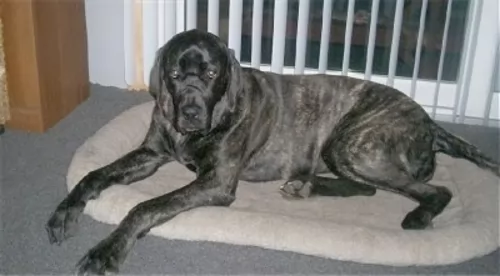 The Giant Maso Mastiff is a fairly new dog breed so you aren’t going to find much history on him.
The Giant Maso Mastiff is a fairly new dog breed so you aren’t going to find much history on him.
The breed was only started in 2001 so as to create a mastiff dog that would have fewer health problems and therefore have the chance to live longer. The Giant Maso came about because of a mix between the Old English Mastiff and the Cane Corso Italiano.
As stated, breeding began in 2001 and the dog has inherited intelligence and protective instincts from both these dogs.
During the 19th century, in the New South Wales, lived a cattle farmer Thomas Hall. He wanted to have a perfect cattle dog so he mixed two breeds: dogs used by stockman with the dingo. The new breed was given an interesting name - Halls Heelers. Heelers was a part of the dog breed because this new breed of the dog inherited the nipping instinct. As time passed, one breed was developing in two breeds: the Australian Cattle Dog and the Australian Stumpy Tail Cattle Dog.
The Australian Cattle dog can be found in two available colours: red and blue. This is how they got their nicknames: Red Heeler and Blue Heeler.
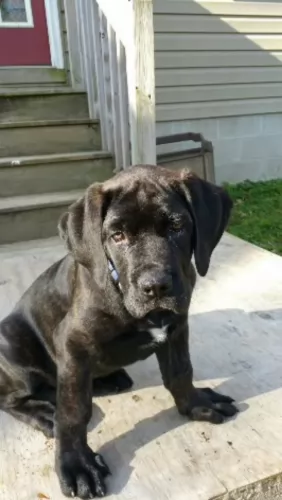 The Giant Maso Mastiff is a large dog breed and can stand at between 67 to 70cm in height and weigh 60 to 90-kg.
The Giant Maso Mastiff is a large dog breed and can stand at between 67 to 70cm in height and weigh 60 to 90-kg.
He has a big square head with medium sized floppy ears and thick neck covered with loose skin. Muscular, he is a deep chested dog with powerful legs and long tail. The fur of the dog is short and sleek and can be a number of colors such as fawn, an apricot color, gray and black as well as brindle.
Intelligent, protective, self-confident, balanced and calm, the Giant Maso Mastiff may be quite an imposing looking dog but he is gentle-natured towards his family.
The large dog loves to please and receive praise from his human family. He is the perfect friend, getting on well with children in the home as well as with other dogs. Training and socialization is easy for this dog and it is important that he is trained if you want him to be an obedient pet.
He is gentle, intelligent, protective – simply known as a gentle giant, being calm, steady and amicable. This breed loves to please and needs lots of companionship from his human family, loving just to lie close by to them.
He isn’t a particularly active dog, but will still need to join you on a walk every day. It is why the Maso Mastiff can live in the city or in the countryside, because not being an overly active dog, he doesn’t need a large garden.
The Australian Cattle Dog originally mixed with Australian herding dog that was kept near the cattle to guide them. Medium-sized, with the short coat, this dog is generally easy to groom and maintain. It does require more brushing during the shedding period, but it is still not an everyday need. He is easy to train because he likes challenging games and activities which are. It gets very attached to its owner, and he is always protective of them and their possessions. The most common health problems happen with their ears and eyes, but they are usually very healthy and they have a long life – up to 15 years.
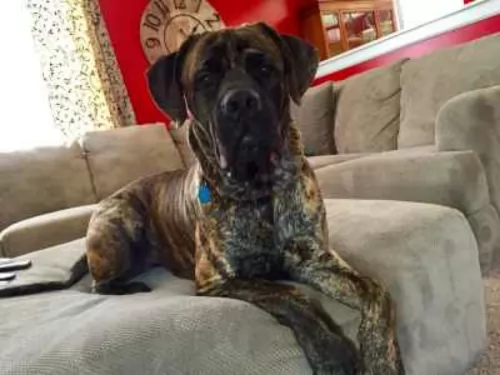 Your Giant Maso Mastiff is such a gentle giant of a dog. He is well behaved and gentle so that it almost seems unnecessary to have him trained and socialized and yet doing so will make him even more amicable.
Your Giant Maso Mastiff is such a gentle giant of a dog. He is well behaved and gentle so that it almost seems unnecessary to have him trained and socialized and yet doing so will make him even more amicable.
Calm and gentle he makes the perfect pet for families where there are children as well as elderly people. He is quite frankly everyone’s friend, being a loving family pet. If you’re a family more into indoor games and TV watching than an outdoor, sporty kind of family, the Giant Maso Mastiff will suit you.
He will love to settle down and watch TV with you. He isn’t particularly active, although he will certainly need a walk every day.
Those who have owned a Giant Maso Mastiff will tell you that this is an excellent family pet, making a wonderful companion dog.
Children and Australian Cattle Dogs can grow up together in harmony. They will have a loyal and protective companion. After you properly train your dog and teach your child how to play with the dog, you will bring the friendship on the safe side. Some of them will have the instinct to nip at heels, so you should pay attention to this while training your pet.
Special talents: cattle dog, service dog, therapy dog, police dogs, drug detection dogs.
Australian Cattle Dogs can survive cool, hot and temperate conditions. They can live in a shelter outdoors, and they do well living indoors. But, be aware – without enough physical activity, this dog will end up being frustrated and unhappy.
They will absorb every new trick so quick that you will be amazed. They love to learn, and if you start with some good trick you will raise a great friend and maybe a great competitor in fetch, swim, bring-a-stick, or run-the-show dog sports.
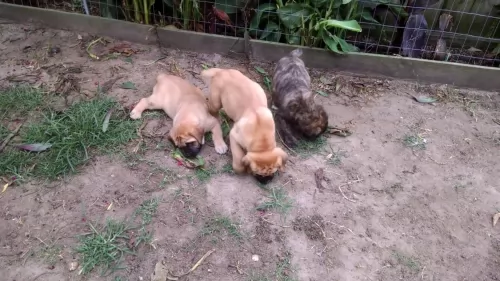 There has always been the concern with joint disorders in large breed dogs. Both hip- and elbow dysplasia can occur with your Giant Maso Mastiff, more so if you overfeed him as a puppy and he grows too fast.
There has always been the concern with joint disorders in large breed dogs. Both hip- and elbow dysplasia can occur with your Giant Maso Mastiff, more so if you overfeed him as a puppy and he grows too fast.
With hip dysplasia, the long bone of the leg forms incorrectly. This can lead to pain and lameness with your pet.
Also check out bloat. This is a serious illness when the stomach fills with air and can twist. Gastric Dilatation-Volvolvus, is an emergency situation then which is found more often in large, deep-chested dog breeds.
If you see your dog with a bloated stomach and acting in a strange, lethargic way, get him to the vet immediately as bloat can be life threatening.
Health Problems: are mostly inherited. You can avoid this by searching for a good breeder that can clear out the hereditary diseases.
The Australian Cattle Dog is one of the breeds that can be born with progressive retinal atrophy. Progressive rod-cone degeneration is a disease that causes the rods and cones in the retina of the eye to degenerate. It might lead to blindness.
The Australian Cattle Dog is one of the rare breeds with recessive piebald alleles. This gene is the reason why they have white colour on their coat. But, unfortunately, this gene can be the reason why congenital hereditary deafness develops.
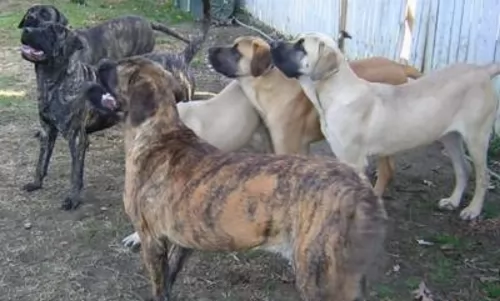 As an average shedder, the smooth, shorthaired coat is easy to groom, and a good brush twice a week will be adequate.
As an average shedder, the smooth, shorthaired coat is easy to groom, and a good brush twice a week will be adequate.
The Giant Maso Mastiff has floppy ears and therefore these should be checked for ear infections. Wax build up and dirt will need to be checked and cleaned.
His nails will need to be clipped, especially if they don’t wear down on their own and his teeth will need to be cleaned 2 or 3x a week to avoid dental disease.
With a large dog breed puppy such as the Giant Maso Mastiff, rapid growth is a risk factor for developing joint and bone conditions. The growth period can last till 12 months and puppies of large breeds should actually have their caloric intake adjusted during this growth period.
It is important to ensure that your puppy grows at a slow, steady rate. If you are feeding dog food from the commercially manufactured range, if you aren’t sure, speak to your vet about large breed dog foods. You want to be sure that this gentle giant of yours receives the best dog food there is, whether commercial branded dog food or your own home-made food. Good nutrition is imperative for the health of your pet.
Herding dog have a history of the joint diseases. That’s why some of the pet suggest feeding a herding dog with meat like chicken, turkey, beef, lamb and fish. Dry dog food, even premium quality, may not be enough for this energetic dogs and their bone structure. But it depends on the dog. The best advice is to always take an advice from your breeder or your wet.
You won’t be very busy with grooming your Australian cattle dog. You don’t have to take everyday care of it. Occasional brushing will be more than enough. Bath the dog only when you notice odour problem.
The Australian Cattle Dog needs a high level of activity. Like many other herding dog breeds, they love walks, spending time with people, running or doing any athletic sports with them, teaching them tricks since they have above average intelligence. Fetching will be super fun for everyone, agility, competitions or any other challenging activity. They love water and they swim very well so you can take the dog with you to the nearest pool and have a great time.